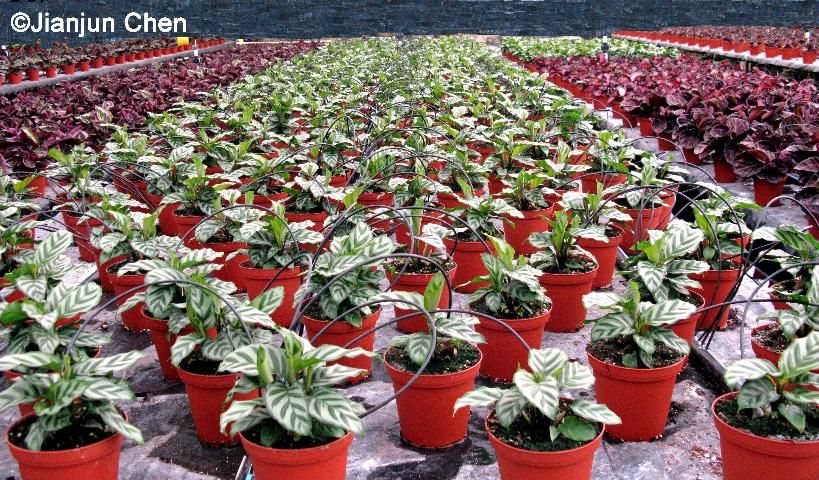Calathea is a member of the family Marantaceae and native to tropical regions of the Americas. The total number of species in the Calathea genus has dramatically increased during the past 50 years, and taxonomists now list about 300 species. Calatheas are perennial rhizomatous or tuberous herbs and have undivided long elliptic to ovate leaves. Some species have only basal leaves while other species have their leaves on short stems. The leaves may be smooth and shiny or covered with small fine hairs, depending on the species. Inflorescences of most species are borne terminally but hidden in their long petioled leaves. Only a few species, such as C. crocata and C. loeseneri, have inflorescences that project above the foliage canopy.
Among the cultivated species, C. allouia is produced for its small gritty tubers, which are eaten like potatoes in the West Indies and northern South America. Some large-leaved species, such as C. lutea, are potential sources of commercial wax, resembling carnauba wax, which is obtained from the undersurface of leaves. Most other Calathea species are grown for their stunning attractive foliage. Their brilliant patterns of leaf color, texture, and elegance attracted wide attention as early as 1861. However, production of calatheas as ornamentals was limited to just a few species until recently new species introduction. In 1975, only three species (C. insignis, C. makoyana, and C. roseopicta) were commonly grown in the US; but now at least 15 species and about 35 cultivars are commonly produced. New cultivars continue to be released by tissue culture laboratories, primarily from somaclonal variants.
This article is intended to describe common cultivars grown in the foliage plant industry, provide guidelines for their culture and interior use, and list physiological problems that may be encountered during production and interiorscape use.
Cultivars
See Table 1.
Cultural Guides
1. Propagation
Calathea species can be propagated by division. The rhizome is divided so each piece has at least one leaf, and then is planted in appropriately sized pots. Only a few species, such as C. micans, can be propagated by seed. Currently, almost all commercial production uses liners from tissue culture.
2. Production
Liners are transplanted in either 6- or 8-inch pots and grown in shadehouses or shaded greenhouses. Soilless media formulated with peat, pine bark, vermiculate, and/or perlite with a pH around 6.0 and soluble salts of 1 to 2 dS/m are suitable for Calathea production. Plants should be grown under at least 80% shade (1000 to 2000 foot candles), with relative humidities between 50 to 100% and temperatures between 70°F and 90°F.
If plants are fertigated via drip or ebb-and-flow irrigation, a nutrient solution with N at 150 ppm can be used. This solution can be made using a water-soluble fertilizer with N-P2O5-K2O at a 3-1-2 ratio, such as a 24-8-16 or 18-6-12 with micronutrients. If a controlled-release fertilizer with the N-P2O5-K2O ratio of 3-1-2 is used, apply it at rate of 3 lb N per 1,000 square feet on a monthly basis.
Potting media should be kept moist but not over-watered when controlled-release fertilizers are used. Growers are strongly recommended to monitor pH and the nutrient status of potting media by checking soluble salts levels at least monthly using pH and electrical conductivity (EC) meters. Media solution can easily be extracted by the pour-through method. If EC readings fall below 1.0 dS/m, additional fertilization is needed, whereas if EC readings are above 3.0 dS/m, growers should reduce either the frequency or amount of applied fertilizer.
It is recommended that fertilizer applications be reduced or eliminated one month before plants are shipped. Leaf nutrient concentrations listed in Table 2 provide a general guide for determining if Calathea is appropriately fertilized.
Shipping and Interior Care
Shipping sleeves are needed for transporting finished Calathea. Recommended temperature range for shipping is 60°F to 65°F as exposure to a temperature below 55°F may cause chilling injury. Irrigate the media thoroughly the day before shipping to reduce stress during transportation.
Calatheas tolerate an interior light level as low as 75 foot candles; but optimal light levels range from 150 to 200 foot candles. Plants maintain their aesthetic appearance better if relative humidity is kept between 40% and 60%. Allow the surface of potting media to dry slightly before watering. Temperatures should be kept between 65°F and 80°F indoors.

Credit: Jianjun Chen, UF/IFAS
Physiological Problems
See Table 3.
Table 1. A listing of common cultivars of Calathea in Florida as of 2005.
Table 2. Nutrient concentrations in leaves considered low, medium, and high for Calathea growth.
Table 3. Causes and effects of various physiological problems of Calathea.